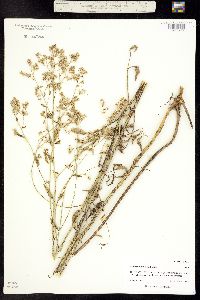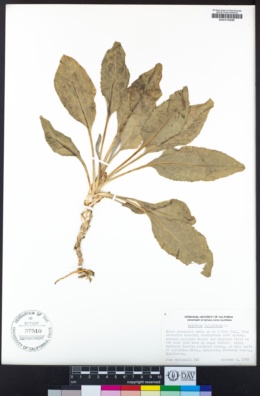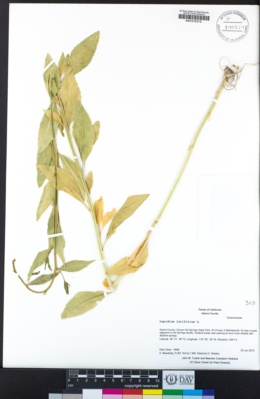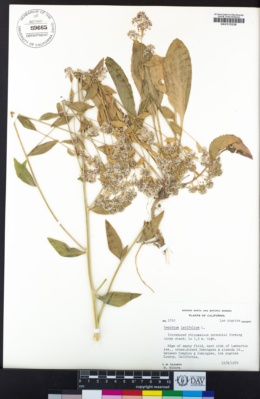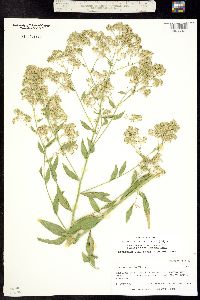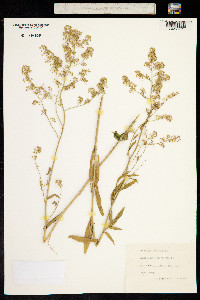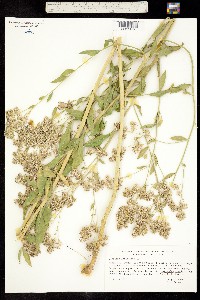Lepidium latifolium
|
|
|
|
Family: Brassicaceae
Broad-Leaf Pepperwort, more...broadleaved pepperweed, broad-leaved pepperweed, broadleaf pepperweed, broadleaved peppergrass, peppergrass mustard, perennial peppercress, perennial pepperweed, tall whitetop, Virginia pepperweed
[Cardaria latifolia (L.) Spach] |
Perennials; (rhizomes thick, caudex woody); glabrous or pubescent. Stems simple from base, erect, branched distally, (2-)3.5-12(-15) dm. Basal leaves not rosulate; petiole 1-9 (-14) cm; blade elliptic-ovate to oblong, (2-)3.5-15(-25) cm × (5-)15-50(-80) mm, (leathery), margins entire or serrate. Cauline leaves sessile or shortly petiolate; blade oblong to elliptic-ovate or lanceolate, (1-)2-9(-12) cm × 3-45 mm, base cuneate, not auriculate, margins serrate or entire. Racemes (subcorymbose panicles), slightly elongated or not in fruit; rachis glabrous or sparsely puberulent, trichomes straight, cylindrical. Fruiting pedicels ascending to divaricate, straight or slightly curved, (terete), 2-5(-6) × 0.1-0.2 mm, glabrous or puberulent adaxially. Flowers: sepals suborbicular to ovate, 1-1.4 × 0.8-0.9 mm; petals white, obovate, 1.8-2.5 × (0.8-)1-1.3 mm, claw 0.7-1 mm; stamens 6; filaments 0.9-1.4 mm, (glabrous); anthers 0.4-0.5 mm. Fruits oblong-elliptic to broadly ovate or suborbicular, (1.6-)1.8-2.4(-2.7) × 1.3-1.8 mm, apically not winged, apical notch 0(-0.1) mm deep; valves thin, smooth, not veined, glabrous or sparsely pilose; style 0.05-0.15 mm, exserted beyond apical notch (when present). Seeds oblong, (0.8-)1-1.2 × 0.6-0.9 mm. 2n = 24. Flowering Jun-Sep. Pastures, grasslands, disturbed places, fields, roadsides, slopes, saline meadows, stream banks, waste grounds, dry flats, sagebrush and pinyon-juniper communities, barren hillsides, ditch banks, edge of marshes; 0-2500 m; introduced; Alta., B.C., Que.; Ariz., Calif., Colo., Conn., Idaho, Ill., Kans., Mass., Mo., Mont., Nebr., Nev., N.Mex., N.Y., Oreg., Tex., Utah, Wash., Wyo.; s Europe; Asia; n Africa; introduced also in Mexico (Durango, San Luis Potosí), Australia. Perennial herb with rhizomes to 2 m tall Flowers: in dense, branched clusters (raceme), which are borne near the ends of branches. Racemes small. Petals four, white. Stamens six. Fruit: a small pod (silicle), 2 mm long, nearly orbicular, rounded at both ends (not notched), sparsely hairy, wingless. Lower leaves: long-stalked, to 30 cm long, to 8 cm wide, hairless or nearly so. Upper leaves: alternate, mostly 1 - 4 cm wide, lance-shaped to narrowly egg-shaped, sometimes toothed, hairless or nearly so. Similar species: Lepidium densiflorum, L. ruderale, and L. virginicum are all similar, but have linear to lance-shaped stem leaves which do not reach 1 cm wide. Flowering: June to early August Habitat and ecology: Introduced from Eurasia. Found along roads (mostly highways) and railroads. Along the coast of New England, this plant was observed growing in saline soil. Occurence in the Chicago region: non-native Etymology: Lepidium comes from the Greek word lepis, meaning scale, which refers to the shape of the silicles. Latifolium means "wide leaves." Author: The Morton Arboretum Rhizomatous perennial to 2 m; herbage glabrous or nearly so; lower lvs long-petioled, to 30 נ8 cm; cauline lvs lanceolate to narrowly ovate, entire to dentate, the main ones 1-4 cm wide; infl paniculately branched, with many short racemes that do not elongate; stamens 6; fr sparsely hirsutulous, suborbicular, 2 mm, wingless, rounded at both ends, not notched; stigma subsessile; 2n=24. Native of s. Europe and w. Asia, established along the coast from Mass. to L.I. and at widely scattered stations elsewhere. Gleason, Henry A. & Cronquist, Arthur J. 1991. Manual of vascular plants of northeastern United States and adjacent Canada. lxxv + 910 pp. ©The New York Botanical Garden. All rights reserved. Used by permission. From Flora of Indiana (1940) by Charles C. Deam Indiana Coefficient of Conservatism: C = null, non-native Wetland Indicator Status: FACW |
















